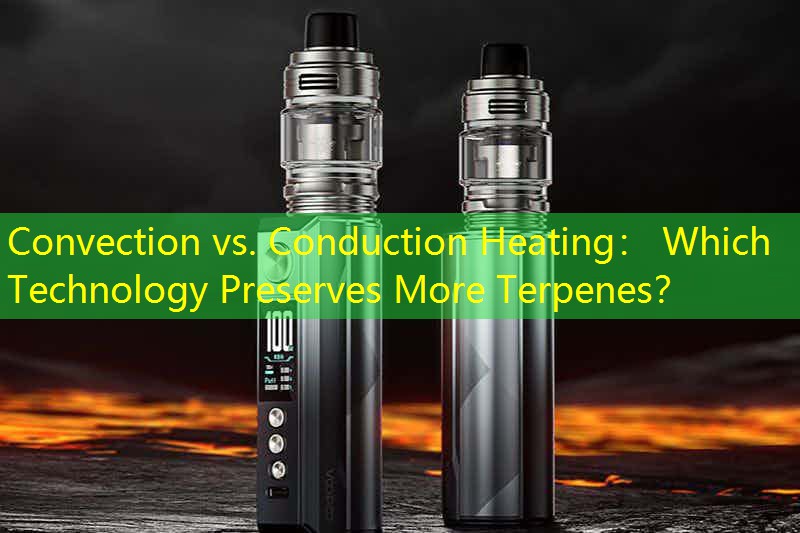Įvadas
Žolelių garinimo pasaulis smarkiai pasikeitė, kai atsirado įvairios šildymo technologijos. Tarp šių, Konvekcinis ir laidinis šildymas sulaukė didelio dėmesio, ypač dėl jų gebėjimo išsaugoti subtilius skonio junginius, žinomus kaip terpenai. Šiame straipsnyje bus nuodugniai apžvelgta konvekcija vs. laidumo šildymo technologijos, įvertinant jų savybes, Vartotojo patirtis, konkurenciniai palyginimai, Argumentai ir trūkumai, ir tikslinių demografinių rodiklių.
Paaiškintos šildymo technologijos
Konvekcinis šildymas
Konvekciniam šildymui augalinei medžiagai netiesiogiai šildyti naudojamas karštas oras, leidžia tolygiai ir tiksliai valdyti temperatūrą. Šis metodas užtikrina, kad aktyvūs junginiai, įskaitant terpenus, yra išgarinami optimalioje temperatūroje, nesudeginant medžiagos. Vartotojai vertina konvekciją už švarius ir kvapnius garus, kurios gali išsaugoti unikalius įvairių atmainų profilius.
Laidumas Šildymas
Priešingai, laidumo šildymas priklauso nuo tiesioginio šildymo elemento ir augalinės medžiagos kontakto. Nors šis metodas dažnai yra greitesnis ir gali suteikti tvirtą garų patirtį, kyla pavojus perkaisti, potencialiai skaidančius terpenus ir kitus lakiuosius junginius. Vartotojai paprastai mano, kad laidumo įrenginiai yra paprastesni ir dažnai pigesni, tačiau dėl greičio jie gali paaukoti skonio vientisumą.

Produkto savybės
Tiek konvekciniai, tiek laidūs garintuvai turi daugybę funkcijų, įskaitant temperatūros kontrolę, perkeliamumas, ir baterijos veikimo laikas. Konvekciniai įrenginiai paprastai turi pažangesnę technologiją, kuri palengvina tikslų temperatūros reguliavimą. Priešingai, laidumo modeliai gali pasiūlyti supaprastintas sąsajas, padaryti juos patogesnius paprastiems vartotojams.
Vartotojo patirtis
Naudotojo patirtis tarp dviejų technologijų labai skiriasi. Konvekciniam šildymui dažnai reikia mokymosi kreivės, kad būtų galima įvaldyti tobulus tempimo ir temperatūros nustatymus. Tačiau, vartotojų praneša, kad atlygis yra turtingesnis, daugiau niuansų skonio. Atvirkščiai, laidumo vartotojai vertina naudojimo paprastumą, tačiau gali pastebėti, kad dėl netolygaus kaitinimo sumažėja skonio profiliai.
Konkurencinis palyginimas
Konkurencingoje aplinkoje, Tokie prekių ženklai kaip „Volcano“ ir „Firefly“ pirmauja konvekcinio šildymo srityje, o PAX ir G Pen pasižymi laidumo galimybėmis. Konvekciniai įrenginiai paprastai būna brangesni, atspindintys jų puikius skonio išsaugojimo gebėjimus. Dar, laidumo garintuvai dažnai patinka taupiems vartotojams, ieškantiems paprastumo ir patogumo.
Argumentai ir trūkumai
Konvekcinio šildymo privalumai
– Puikus terpeno išsaugojimas
– Tolygus šildymas
– Didesnis skonio gylis
Konvekcinio šildymo trūkumai
– Didesnė kaina
– Sudėtingesnis naudojimas
Laidumo šildymo specialistai
– Greitas įšilimo laikas
– Patogus vartotojui
– Paprastai pigiau
Laidumo šildymo trūkumai
– Galimas netolygus šildymas
– Skonio pablogėjimo pavojus
Tikslinio vartotojo analizė
Konvekcinių garintuvų tikslinė demografinė grupė paprastai apima žinovus ir įžvalgius vartotojus, kurie teikia pirmenybę skoniui ir kokybei.. Šie asmenys dažnai nori daugiau investuoti į aukščiausios kokybės produktą. Priešingai, laidumo prietaisai pritraukia daugiau atsitiktinių vartotojų arba tuos, kurie dar nepažįsta žolelių garinimo, nes jie siūlo prieinamą įėjimo tašką be didelių žinių apie temperatūros kontrolę ar garinimo būdus.

Išvada
Apibendrinant, pasirinkimas tarp konvekcinio ir laidinio šildymo labai priklauso nuo individualių pageidavimų ir prioritetų. Konvekcija suteikia puikią patirtį tiems, kurie nori išsaugoti terpenus ir mėgautis sodriais skoniais, o laidumas siūlo paprastumą ir greitį paprastiems vartotojams. Šių skirtumų supratimas yra labai svarbus norint priimti pagrįstą sprendimą dinamiškame žolelių garinimo pasaulyje.







